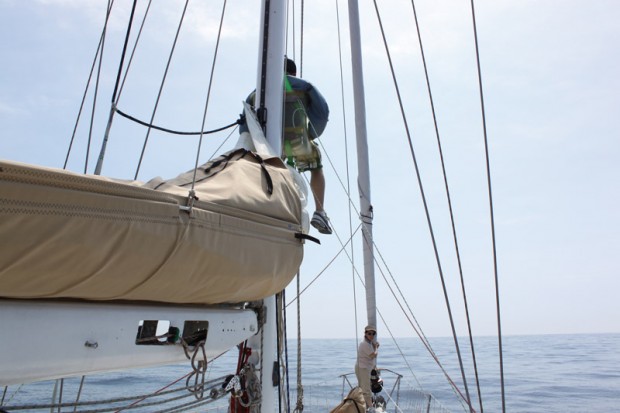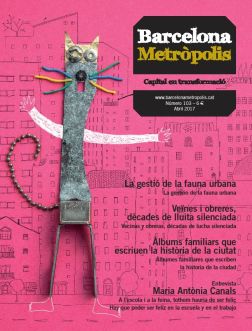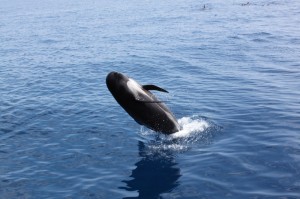For years, Barcelona has been open to the sea, but we need to renew this connection and teach the public that the seafront still has natural treasures that should be seen as assets to the city and its inhabitants.

Marine protection activities in the Canyons del Maresme marine reserve, where, in 2009, SUBMON launched a project, with the support of the Catalan Regional Government, aimed at promoting public participation in measures to protect cetaceans.
Photo: C. Álbarez / SUBMON
Regardless of whether it’s a big fish, a shark, a dolphin or a whale, the arrival of any sea creature of a certain size to our coastline awakens a whole spectrum of feelings ranging from curiosity, fear, ignorance and incredulity. Almost daily, the newspapers feature stories of dolphin sightings from sightseeing boats right outside the harbour, or of a paddle surfer who spotted a whale off Mar Bella beach, or that a pod of bottlenose dolphins played alongside children on the teaching boats of the Municipal Sailing Centre (CMV). These mammals always spark our interest. And for 55 million years, cetaceans (dolphins and whales) have been changing and adapting to their underwater life. It’s not just in Barcelona that people lack awareness: in most major cities, people know more about species of the faraway African savannahs than about the marine animals that live in the sea they bathe in.
Barcelona is enclosed by two rivers, a coastal mountain range and the Mediterranean Sea. Both rivers have improved in recent years, environmentally speaking, while Collserola has become a more important feature of the city, providing it and its inhabitants with many natural assets. But the same cannot be said of the sea, which has still not lost its leading role in Barcelona’s holy trinity:, sun, sea and sand. For years Barcelona has been open to the sea, but we now need to renew this connection and make the public understand that the seafront has natural treasures that should be seen as assets to the city and its inhabitants.
Eight species of cetacean are regularly found in the Mediterranean: common bottlenose dolphins (Tursiops truncatus), striped dolphins (Stenella coeruleoalba), short-beaked common dolphins (Delphinus delphis), Risso’s dolphins (Grampus griseus), long-finned pilot whales (Globicephala melas), Cuvier’s beaked whales (Ziphius cavirostris), sperm whales (Physeter macrocephalus) and fin whales (Balaenoptera physalus), which is the second largest animal on the planet after the blue whale.
Some 30 members of these species get beached or die on the coasts of Barcelona each year. Barcelona’s seafront is obviously an area that many of these animals still pass through, either on daily short trips to find food (bottlenose and striped dolphins) or on their seasonal migration, like the fin whales, which, according to fishermen, start to appear around Easter along the Barcelonès and Maresme shorelines, ending up in the northern Mediterranean in the summer, where they go to feed.
It’s worth remembering that, to various degrees, all cetaceans are protected species and that there is a law (Spanish Royal Decree 1727/2007) which specifically governs how to approach them if you spot them.
Initiatives to protect cetaceans
Two main initiatives are under way to raise awareness of these species and to harness the involvement of the public in their conservation.
Metropolitan Dolphins (Dofins Metropolitans) was set up in 2012 as a joint project between Barcelona City Council’s Department for the Environment and SUBMON, a marine environmental consultancy. The project’s objective is to gather information on the presence of dolphins and other marine vertebrates along the Barcelona coastline and then use this data for the purposes of communication, environmental awareness-raising and in various of SUBMON’s research activities.
In addition, Barcelona’s marine environment forms part of the “Canyons del Maresme” marine reserve, which is where SUBMON set up a project in 2009, with the support of the Catalan Regional Government, to encourage the public to get involved in the conservation and protection of the area’s cetaceans. The fact that this area is within the sphere of influence of the most densely populated districts in Barcelona makes its role as a marine biodiversity reservoir in a peri-urban space even more important.
These initiatives aim to act as meeting points for users of the marine environment: users who want to provide and consult information on coastal sightings; spread knowledge of the value of our natural marine heritage, including in Barcelona; and stress the importance that, even today, we can share our coasts with these wonderful sea creatures.




